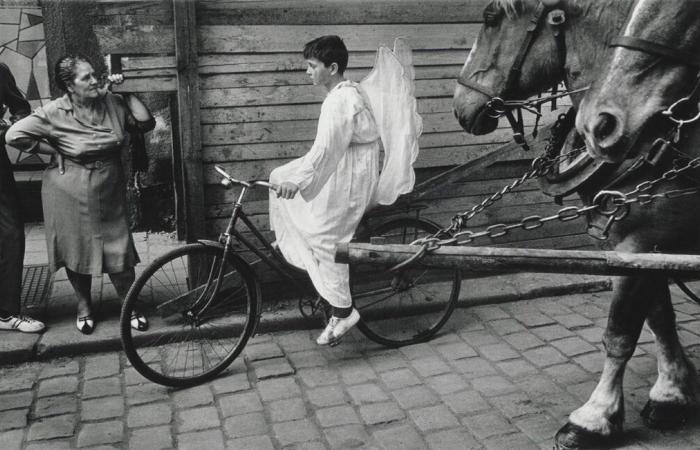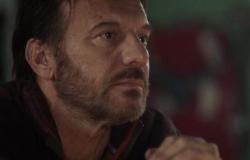The strong commitments which characterized the links between the Fnac and photography – works and artists – have marked French society for decades. From 1966, after allowing amateurs to pick up a camera, Fnac transformed its stores into exhibition galleries, further strengthening the democratization of photography.
To testify to this very special relationship between Fnac and photography, a 300-page book “Regards. A century of photography, from Brassaï to Martin Parr. Masterpieces from the Fnac collection” published by Gallimard, which highlights 250 images by Berenice Abbott, Robert Capa, Henry Clarke, Philippe Halsman, André Kertész, William Klein, Inge Morath, Man Ray… under the direction by Quentin Bajac.
These works were chosen from the 1,800 photographs in the Fnac collection. This unique ensemble was entrusted for conservation, in 2014, to the Nicéphore Niépce museum in Chalon-sur-Saône.
Laura Serani écrit :
Regards, published on the occasion of Fnac's seventieth anniversary, recalls the pioneering role that Fnac played, through its photo galleries and one of the first dedicated private collections, in the dissemination and recognition of photography in France, for more than thirty years.
If the invitation to write a text for this book gave me great pleasure, the two adjectives specifying “short and personal” frightened me a little, the first by the difficulty of summarizing an experience as important as that of Fnac , the second by the truly personal nature of my story with Fnac and with the collection, about which I have never written until now.
The undertaking was to prove even more difficult, but… here is the story.
At the origin of Fnac two friends, brilliant and visionary, André Essel and Max Theret who declared themselves Trotskyists without embarrassment while they launched into an original system of selling household appliances and cameras.
At the beginning of the economic boom, they defended the right for all to consumer goods and culture, at the same time as others, with the creation of Club Med, defended access to vacations for all in dream places.
It was an era which allowed successes and utopias, uninhibited mixtures, generous and ambitious projects, which left great freedom and room for imagination.
It is this spirit, which remained the foundation of Fnac for a long time, which won me over to the point of making me stay for more than twenty years, whereas when I arrived at the Photo Galleries in May 1983, I thought I was moving away from my course oriented towards literature and cinema, just long enough for a summer job.
1983, the departure of André Essel, the founder, coincides with that of Gjl Mijangos, another legendary figure of the Fnac house, instigator after Jacques Cherix of the brilliant concept of installing photography galleries in stores and helping photographers by buying prints from them at a time when the idea of “collecting” was not very widespread. At that time, the communications department was reorganized; a very young man, François Hébel, took over the head of the Galleries accompanied for two weeks by Claude Nori, also a pioneer in publishing. An assistant position is being created. Not at all intimidated by my lack of experience, they accepted my application and I found myself working for the first time in an office, in a company with a very particular identity, alongside them. Claude Nori had to return very quickly to his publishing house, Backlight, and François Hébel, after noted projects like Rushes and the launch of a collection of boxes / catalogs of exhibitions – among others by Erwin Blumenfeld, David Bailey or the Sipa Agency – will be called, two years later, by Lucien Clergue to direct the Rencontres d'Arles . So in a short time I found myself at the head of a department which, at the time, played a fairly unique role, with a proliferation of exhibitions and events around photography, initially in the big cities. then throughout France, Europe and elsewhere. My first day of work began at Fnac Montparnasse with Edouard Boubat, for the assembly of his exhibition; his discretion, his lordly manners and his gentleness, equal to that of his images, undoubtedly marked my first impressions and the rest of the story.
We can say that Fnac and I grew up together… In a sort of community, with great figures of the last century, who often became friends, such as Cartier-Bresson, Martine Franck, Inge Morath, Ronis, Riboud, Burri, Klein, Jean-François Bauret, Sabine Weiss, Larry Fink, Sarah Moon, Malick Sidibé, Plossu, Depardon or Salgado… with whom I learned a lot, professionally and human ; with other friends like Paulo Nozolino, Gérard Rondeau, Max Pam, Stephane Duroy, Machiel Botman… we experienced together the evolution of photography and the photographic scene, shared questions, sought new answers. With the development of Fnac and the increase from five to one hundred and five stores, in Europe then in Brazil and Asia, the horizons soon expanded.
At the beginning of the 2000s, with an enthusiastic and very talented team of around ten people, based in Paris, we designed and produced fifty new exhibitions each year, which toured every two months in all the galleries, relying on on the communications managers of each store, as well as an audiovisual magazine Fnac sequence dedicated to visual arts, short films and music.
Exhibitions by recognized artists, such as Brassai, Berenice Abbot, Man Ray, Duane Michals, alternated in galleries – in a space not always ideal – with those of major artists but not yet very well known in France such as Ugo Mulas, Luigi Ghirri , Gabriele Basilico, Gianni Berengo Gardin, Chris Killip, or with the first exhibitions of African photographers such as Seydou Keïta, Malick Sidibé, Samuel Fosso, Santu Mofokeng, or from Latin America, like Sergio Larrain and Alberto Korda, from the Middle East with Malekeh Nayiny and Shirin Neshat but also artists from other universes, such as Pedro Almodovar, Wim Wenders, Allen Ginsberg, Jonas Mekas, Stanley Kubrick, as well as young photographers.
If I talk so much about the exhibitions here, it is because without them, it is impossible to talk about the Collection.
The Collection was born as the memory and mirror of the temporary exhibitions presented over time in the galleries. Created in the 1970s, it developed significantly in the 1990s and 2000s. The variety of writings and themes covered corresponds to the choice of restoring the state of creation as well as bearing witness to the state of the world. , hence, for example, a significant presence of documentary photography and photojournalism, a genre which found little or no place elsewhere on the walls.
During the twenty years in which I managed exhibitions and acquisitions, an editorial line emerged, each image having been chosen as a documentary testimony or poetic act, as an expression of the concerns of the world and the photographic language at a given moment, by its messages or its metaphors, by the emotions or the memories that it could arouse. Like the program of exhibitions, the collection was naturally constituted, guided by my curiosity and my eclectic centers of interest, literature, music, cinema, social themes, without borders between disciplines and always with a focused view towards elsewhere and other realities.
Frequented by a large and varied public, Fnac thus played the role of a real media which made it possible to raise awareness among customers and visitors as much about culture as about social issues: the situation of psychiatric hospitals in Europe, the first wave of AIDS, poverty, road safety, the realities of the suburbs, repeated conflicts in the Middle East, the complexity of Africa…
With each change of ownership, under each “reign”, the spirit and generosity of the founders have remained the principles of photographic policy. After André Essel, the Coops, then the Gmf — with the creation of the Fnac Foundation which made it possible to support major projects, such as the evening Rock and Photo or Imaginary Albums at the Rencontres d'Arles or the Mois de la photo in Paris — and then PPR, with the attention and sensitivity of François Pinault and François-Henri Pinault towards the collection, which enabled a significant number of acquisitions.
We had the space and the freedom to “do culture” independently and often despite commercial objectives, with a large area dedicated to photo galleries and forums right in the heart of the stores. Sometimes the publication of a book coincided with an exhibition, in the interest of its authors as much as of Fnac, but the vast majority of exhibitions were the result of original projects, whether those of Berenice Abbott, by Man Ray, Allen Ginsberg or the project set up with MSF and Reporters Without Borders to send Yann Morvan and Reza to Burundi and Rwanda to bear witness to the genocide in progress in an exhibition and a newspaper published in full emergency, while the French press barely spoke about it.
The collection brings together all these stories, masterpieces and testimonies of our time. Stories of encounters, such as the friendship with Gilberte Brassai who, with a donation, left to the Collection the eighty prints from Brassai's exhibition on the night which had won the Public Prize during Photo Month in 1988; or with Lucien Treillard, who, in the 90s, donated the two Man Ray exhibitions from his collection, presented together at Fnac, or Benedict Fernandez who bequeathed a significant number of prints, precious testimonies of the struggles in the USA for civil rights and against the Vietnam War.
The images that constitute the collection are, for the most part, acquisitions parallel to the production of the exhibitions, rather than vintages. These are modern prints, produced under the control of the authors or their beneficiaries, signed or authenticated but not numbered. This bias corresponds on the one hand to the reality of dominant photography at the time, widely represented in the collection, according to the philosophy of Henri Cartier-Bresson supporting the principle of the reproducibility of the work, but also to the choice of to be able to acquire a greater number of images in an educational logic of dissemination of photography, rather than from a heritage or speculative perspective, far from the criteria of the art market.
In 2004 for the fiftieth anniversary of Fnac, we published the book Photography between history and poetry, title suggested by Gabriele Mazzotta, a great Italian art publisher, which well reflected the spirit of the collection. At the same time, an exhibition in the hall of the men of arms of the Conciergerie in Paris unfolded the story of the century in four hundred images, and an exhibition, on the gates of the Jardin du Luxembourg, presented a hundred photos which marked the history of the 20th century photographye century. Twenty years later, it is a pleasure to see the Collection once again accessible to the general public thanks to this beautiful book, to the events planned in Paris in the fall and to the exhibition which Fnac entrusted me with curating, for which I proposed a thematic selection under the title The century of vacations. The preparation of this project, presented in Deauville on the occasion of the Planches Contact Festival, allowed me to immerse myself in this collection which has awakened so many memories and which, I hope, will awaken so many rediscoveries and surprises among visitors and emotions. Enjoy your trip through images.
Laura Serani
“Looks. A century of photography, from Brassaï to Martin Parr. Masterpieces from the Fnac collection. »
under the direction of Quentin Bajac, published by Gallimard.
262 x 290 mm, 304 pages, 250 illustrations.
ISBN 207310066X
45 €
https://www.fnac.com/a20755604/Quentin-Bajac-Regards-Un-siecle-de-photographie-de-Brassai-a-Martin-Parr






